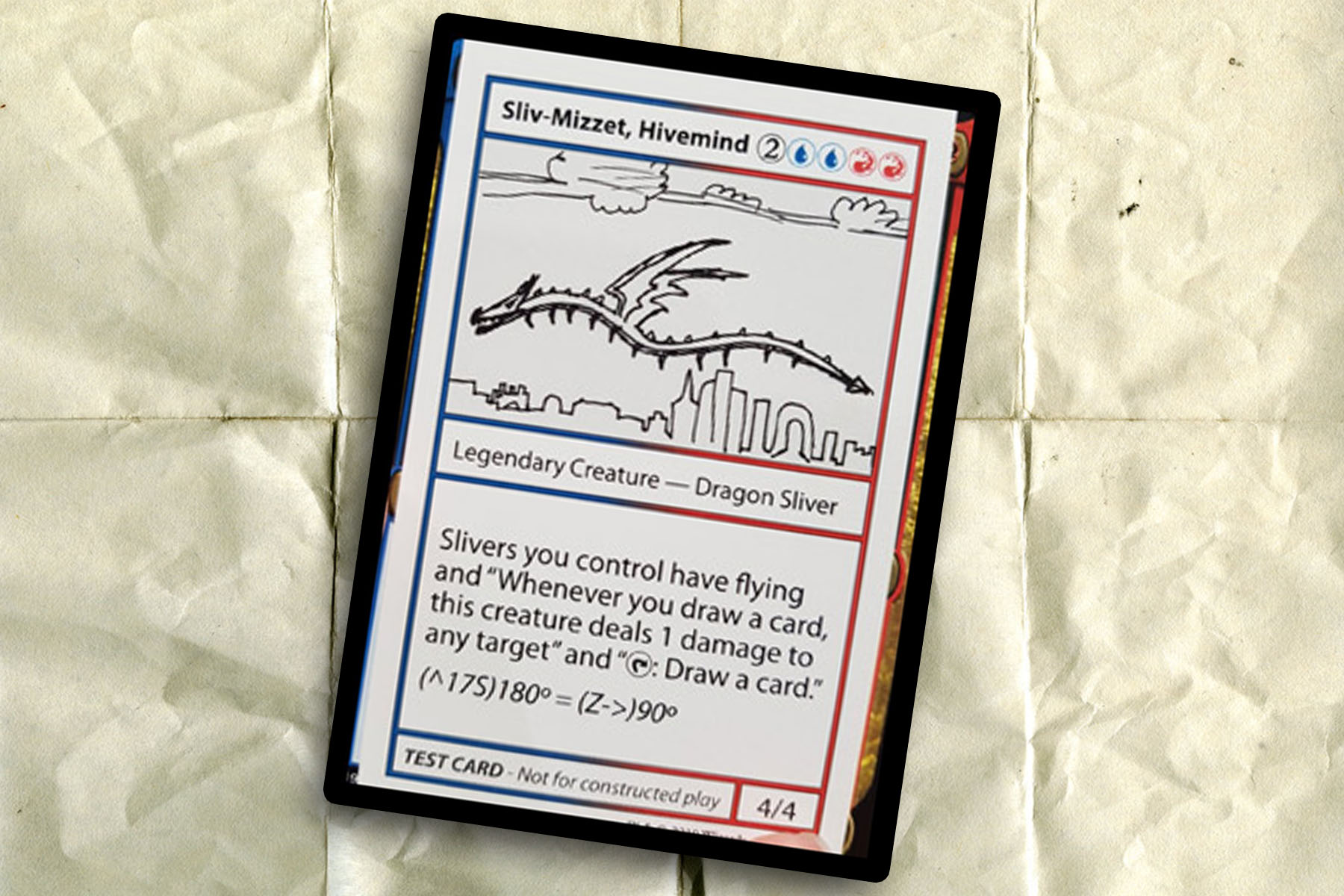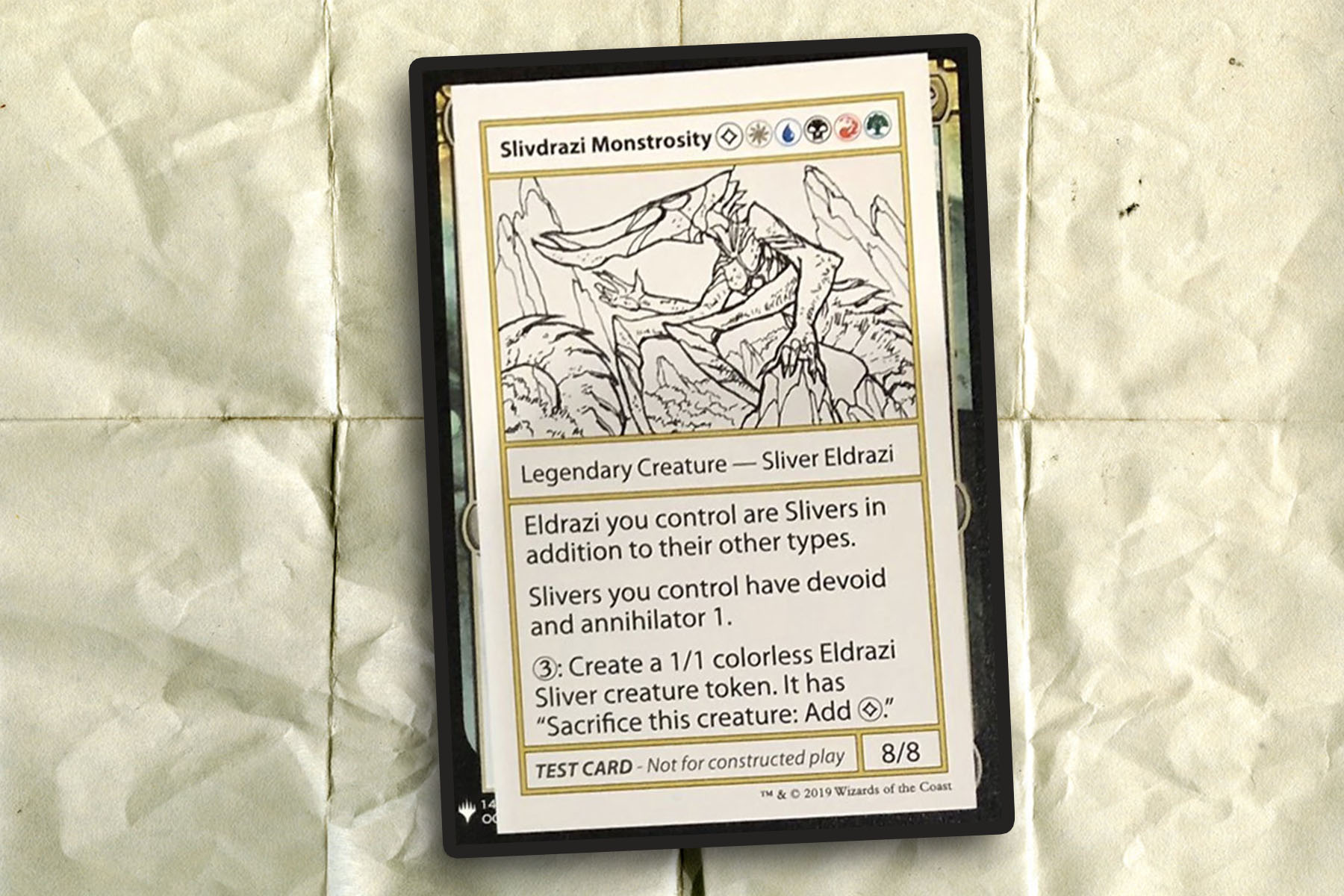As we move into the end of the year, I find myself craving structure to help streamline the busy months ahead. As I drew up a plan for November, I happened to list this week as “mystery box” since I had no concrete idea. Subconsciously or not, this aligned perfectly with the unveiling of the contents of the Mystery Booster. As you likely know, last weekend we were given a look into what the Mystery Booster Convention Pack looked like, including a special set of playtest cards showing up in each pack.
When this product was originally announced I foolishly didn’t think there would be any overlap with Commander. But upon the reveal of these playtest cards, I saw two in particular that captured my attention: Slivdrazi Monstrosity and Sliv-Mizzet, Hivemind. They both tickled me and fed into my love of Slivers and Eldrazi.
After some thought, these two cards revealed one of my personal measuring sticks. While similar in their designs, these two cards fall on opposites sides of what I believe merits a reasonable “unofficial” general for Commander. So today I will investigate these two cards to best describe my sensibilities regarding each of them.

Sliver Science Fair
Looking at the playtest cards, it’s easy to draw direct comparisons to the Un-sets. I’ve written about this in the past; but for context, I am a player who went into Unstable with absolutely no positive memories of any silver-bordered card ever being cast, besides Booster Tutor. Unstable did a lot to change my perspective in a positive way, to the point where I was willing to look at silver bordered cards on a card-by-card basis for eligibility in Commander games among my private playgroups. Fads eventually fade, even in Commander and outside of Cube, I haven’t cast a silver bordered card in the last year.
On the surface, Sliv-Mizzet reads like a fantastic combo general. With every member of our team being a non legendary Niv-Mizzet, the Firemind, we should be able to string together Brainstorm and Faithless Looting to win in the most dramatic of ways. But then the rules text and the gameplay it endorses sink in and you realize this: by simply having it on the battlefield, the game is bound to end with as little as an additional blue mana in the most dramatic of ways.
For many, that probably sounds like the kind of deck they would like to play and that would bring them joy. To me that plan would get old fast, making this card into more of a joke than a serious contender. Because of where the influence for Sliv-Mizzet comes from, I believe it’s more functional than most silver bordered cards, but not by much. For my personal tastes, it lacks the nuance to really allow a strategy to be built around it and allow for a reasonable game of Commander to be played. Luckily, the argument against it can really end there, because this card wasn’t explicitly designed for Commander and can live in an ecosystem of Cube.
Not everything is negative about this card though. While Sliv-Mizzet is certifiably broken, what actually attracted me most was the idea of a legendary sliver that was not all five colors. As a fan of tribal decks, I love diversity and prefer when a tribe doesn’t have a defacto jack-of-all-trades general. I understand that sliver fans will look for a new five-color sliver in any set featuring the tribe, but I think the tribe is saturated enough with these legends that I would endorse the idea of giving us the tools to limit the sliver builds we could construct in Commander. Maybe I’m alone in that feeling, but I think Sliv-Mizzet was on the right track in that regard.
A Color Out of Space
Since Sliv-Mizzet didn’t have the chops to seriously helm a full Commander deck, it’s reasonable to ask if there is any nuance to building around this Slivdrazi Monstrosity. Whereas I was willing to let Sliv-Mizzet go under the pretense that it’s not designed for Commander, I’m willing to make a case for the Eldrazi Sliver to be taken into consideration. The difference may come down to a razor edge, but I believe this card functions enough like something we would find in a supplementary set like Battlebond or Conspiracy to have merit and helm a deck. Though, I wouldn’t mind if it got a few more laps in Development before it graduated out of the playtesting frame.
In the hypothetical world where a playgroup allowed unconventional generals, this deck could answer vulnerabilities that the typical silver deck often has, especially in the realm of board wipes. In my experience, one of the main things that stands in the way of slivers is the pesky creatures around to block. Sadly, Shifting Sliver is only one card in a library of 99. But once all our slivers gain devoid, suddenly they are are able to take advantage of spells that look for one or more colors on permanents.
One of the easiest places to start is with All is Dust, but a case can also be made for now slotting Hibernation, Riptide, and Wash Out in as well. Bouncing everyone else’s creatures to their hands might as well be destroying them in many cases as allowing a swarm of slivers to act unencumbered is dream scenario of them. But this goes even further when we use Spreading Plague, one of my pet cards, as a way to insure that our opponents will struggle to keep creatures on the board while we continue to act with impunity.
Before even considering actual Eldrazi—which surprisingly might not be necessary—the average sliver deck packs in about 25 to 30 creatures. Once you account for lands being anywhere from 35 to 40 cards in a deck, slivers are half of the remaining cards. This means we could be nearly unaffected by Mana Maze, which now might as well be an asymmetrical copy of Arcane Laboratory.
Even if we wanted to take away the Eldrazi typing, there is a use for a legendary Ghostflame Sliver that allows for you to build around a colorless army of creatures. This is why I believe the Monstrosity could work whereas Sliv-Mizzet didn’t. And on the flip side, the idea that you could graft sliver abilities onto creature with bigger bodies takes my premise for Volrath, Shapestealer and cranks in up to eleven.
Slivdrazi Monstrosity is by no means a perfect card. As fun as this deck would be for me, it likely does create the problem of taking two very iconic creature types in Magic and blurring them together to create what would ultimately prove to be a defacto best general for both tribes.
I realize that neither of these two cards were ultimately intended for any constructed format and are best utilized as build-around cards in tribal heavy Cubes. But I was fascinated by what the Mystery Boosters brought to the table for Commander, even if only for a series of hypothetical situations. I will maintain my stance that playgroups should always been reasonably open to allowing their players to explore new twists with some freedom.
If any of these playtest cards do happen to take off in Commander, please be considerate to discuss it with your playgroup beforehand and disclose the existence of any—not necessarily by name—in use at the start of the night. And if you fall on the side of being opposed to any of these cards, tell your playgroup in a respectful way why you might be opposed to this subset of cards being included.
Whether a card comes out of a set like Mystery Boosters or a fan-made set off of Reddit, what I most often look for is function and reasonable lines of play. I see these two legends sitting very close to the line of what is acceptable for me in that regard, just on opposing sides. Next week, I promise to be little more constructive. Join me then.
Ryan Sainio is a Graphic Designer who writes about EDH and the EDH community. He has been playing Magic: The Gathering since 7th Edition in 2002 and values flavorful and fun gameplay over competitively optimized decks.


